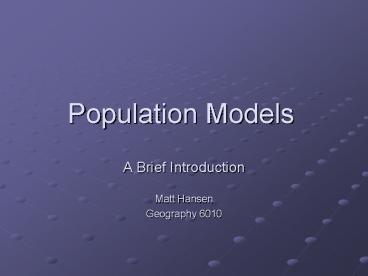Population Models PowerPoint PPT Presentation
Title: Population Models
1
Population Models
- A Brief Introduction
- Matt Hansen
- Geography 6010
2
Overview
- Basic modeling techniques
- Population modeling techniques
- Difference and differential equations
- Conclusions
3
Evolution of Population Modeling Techniques
4
Choosing an Appropriate Model
- Know model objectives
- Simple models
- Easy to create
- Not representative of reality
- Huge models
- Universally applicable
- Complex, expensive, and quickly obsolete
- A happy medium?
5
Spatial Modeling
- Benefits of spatial analysis
- Spatial dynamics
- Spatial heterogeneity
- Spatial relationships
- Spatial Analysis Tools
- Spatial statistics
- Cellular automata
- Metapopulation modeling
- GIS
6
Basic Population Model
7
Modeling with Difference Equations
- Population in each time period is a function of
the previous periods population - Nt1 f (Nt)
- Linear function
- Nt1 (1r)Nt
- (N population t period of time r growth
rate births-deaths)
8
Malthusian Growth Model
- 1798 Thomas R. Malthus
- Unchecked human populations double every 25 years
- Constant growth rate regardless of size
- 100 ? 135
- 1,000 ? 1,350
- 10,000 ? 13,500
- . . .
9
Malthusian Growth Model
- N(t) N0ert
- N0 population size at t 0
- N(t) population at given time (t)
- t time
- r growth rate per unit time
10
Logistic Difference Equations
- Nt1 r Nt (K Nt/K)
- K carrying capacity
11
Logistic Difference Equations
- Age structure dependencies
- Competition
- Lotka-Volterra predator-prey equation
- Chaos
12
Differential Equations
13
Conclusions
- Model format should be determined by desired
level of complexity - Geographers offer a unique spatial perspective to
modeling - Malthusian growth modeling forms the foundation
of much of population modeling - Future Geocomputation topics will add to an
understanding of these techniques
PowerShow.com is a leading presentation sharing website. It has millions of presentations already uploaded and available with 1,000s more being uploaded by its users every day. Whatever your area of interest, here you’ll be able to find and view presentations you’ll love and possibly download. And, best of all, it is completely free and easy to use.
You might even have a presentation you’d like to share with others. If so, just upload it to PowerShow.com. We’ll convert it to an HTML5 slideshow that includes all the media types you’ve already added: audio, video, music, pictures, animations and transition effects. Then you can share it with your target audience as well as PowerShow.com’s millions of monthly visitors. And, again, it’s all free.
About the Developers
PowerShow.com is brought to you by CrystalGraphics, the award-winning developer and market-leading publisher of rich-media enhancement products for presentations. Our product offerings include millions of PowerPoint templates, diagrams, animated 3D characters and more.

